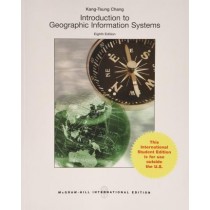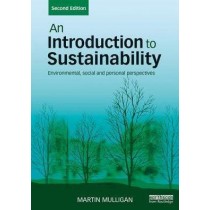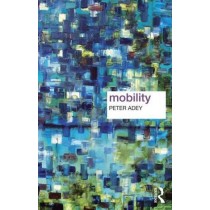Geography
-

Introduction to Economic Geography
Pages: 428,
Specialty: Geography,
Publisher: Taylor & Francis,
Publication Year: 2019,
Cover: Paperback,
Dimensions: 191x248x25.4mm
In the context of great economic turmoil and uncertainty, the emergent conflict between continued globalisation and growing economic nationalism means that a geographical economic perspective has never been so important. An Introduction to Economic Geography guides students through the key debates of this vibrant area, exploring the range of ideas and approaches that invigorate the wider discipline. This third edition includes new chapters on finance, cities and the digital economy, consumption and the environment. Underpinned by the themes of globalisation, uneven development and place, the text conveys the diversity of contemporary economic geography and explores the social and spatial effects of global economic restructuring. It combines a critical geographical perspective on the changing economic landscape with an appreciation of contemporary themes such as neoliberalism, financialisation, innovation and the growth of new technologies. An Introduction to Economic Geography is an essential textbook for undergraduate students taking courses in Economic Geography, Globalisation Studies and more broadly in Human Geography. It will also be of much interest to those in Planning, Business and Management Studies and Economics. show more
Weight: 1.04 KG
Learn More -

Introduction to Geographic Information Systems, 8E
Specialty: Geography,
Publisher: McGraw-Hill,
Publication Year: 2016,
Cover: Paperback,
Dimensions: 188x234x17mm
Weight: 0.68 KG
Learn More -

Introduction To Geography, 15e
Specialty: Geography,
Publisher: McGraw-Hill,
Publication Year: 2018,
Cover: Paperback,
Dimensions: 226x274x20mm
Getis' Introduction to Geography is written to clearly and concisely convey the nature of the field of geography; its intellectual challenges, and the logical interconnections of its parts. Even if students take no further work in geography, they will have come into contact with the richness and breadth of the subject and have new insights and understandings for their present and future roles as informed adults. This new edition provides students content and scope of the subfields of geography, emphasising its unifying themes, and providing the foundation for further work in their areas of interest. A useful textbook must be flexible enough in its organization to permit an instructor to adapt it to the time and subject matter constraints of a particular course. Although Getis Introduction to Geography is designed with a one-quarter or one-semester course in mind, this text may be used in a full-year introduction to geography when employed as a point of departure for special topics and amplifications introduced by the instructor or when supplemented by additional readings and class projects. show more
Weight: 0.92 KG
Learn More -

Introduction to Geopolitics
Pages: 334,
Specialty: Geography,
Publisher: Taylor & Francis,
Publication Year: 2017,
Cover: Paperback,
Dimensions: 174x246x20mm
This new updated edition of Introduction to Geopolitics presents the overarching themes of geopolitical structures and agents in an engaging and accessible manner, which requires no previous knowledge of theory or current affairs. Using new pertinent case studies and guided exercises the title explains the contemporary global power of the United States and the challenges it is facing, the persistence of nationalist conflicts, migration, cyberwar, terrorism, and environmental geopolitics. Case studies of the rise of the so-called Islamic State, the South China Sea disputes, the Syrian civil war, the Korean conflict, and Israel-Palestine emphasize the multi-faceted nature of conflict. The book raises questions by incorporating international and long term historical perspectives and introduces readers to different theoretical viewpoints, including feminist contributions. The new edition features expanded sections on network geopolitics and non-state actors, a new section on geopolitics of transnational business, cyberwar, an interpretation of ISIS within historical geopolitical trends, as well as expanded discussion of the relevance of Boserup and neo-Malthusians to environmental geopolitics. Introduction to Geopolitics will provide its readers with a set of critical analytical tools for understanding the actions of states as well as non-state actors acting in competition over resources and power. Both students and general readers will find this book an essential stepping-stone to a deeper and critical understanding of contemporary conflicts.show more
Weight: 0.57 KG
Learn MoreKWD9.90 -

Introduction to Sustainability
Pages: 338,
Specialty: Geography,
Publisher: Taylor & Francis,
Publication Year: 2018,
Cover: Paperback,
Dimensions: 171x248x19.05mm
An Introduction to Sustainability provides students with a comprehensive overview of the key concepts and ideas which are encompassed within the growing field of sustainability. The fully updated second edition, including new figures and images, teases out the diverse but intersecting domains of sustainability and emphasises strategies for action. Aimed at those studying the subject for the first time, it is unique in giving students from different disciplinary backgrounds a coherent framework and set of core principles for applying broad sustainability principles within their own personal and professional lives. These include: working to improve equality within and across generations; moving from consumerism to quality of life goals; and respecting diversity in both nature and culture. Areas of emerging importance such as the economics of prosperity and wellbeing stand alongside core topics including: * Energy and society * Consumption and consumerism * Risk and resilience * Waste, water and land. Key challenges and applications are explored through international case studies, and each chapter includes a thematic essay drawing on diverse literature to provide an integrated introduction to fundamental issues. Housed on the Routledge Sustainability Hub, the book's companion website contains a range of features to engage students with the interdisciplinary nature of sustainability. Together these resources provide a wealth of material for learning, teaching and researching the topic of sustainability. This textbook is an essential companion to any sustainability course. show more
Weight: 0.59 KG
Learn MoreKWD14.40 -

Migration
Pages: 506,
Specialty: Geography,
Publisher: Taylor & Francis,
Publication Year: 2017,
Cover: Paperback,
Dimensions: 138x216x28mm
While the subject of migration has received enormous attention in academic journals and books across the social sciences, introductory texts on the matter are few and far between. Even fewer books have explored migration through a critical and explicit engagement with spatial concepts. Now in its second edition, Migration remains the only text in more than a decade that emphasizes how geographical or spatial concepts can be used critically to understand migration. The multi-disciplinary text draws on insights from human geography, political science, social anthropology, sociology, and to a lesser extent economics. All of the chapters focus on key terms, theories, concepts, and issues concerning migration and immigration. The book argues that in the context of migration, two opposing 'spatial positions' have emerged in the wake of the critique of 'methodological nationalism'. On one hand is the significance of 'transnationalism', and on the other, the importance of 'sub-national' or local processes.Both require more nuance and integration, while many of the concepts and theories which have thus far neglected space or have not been 'treated' spatially, need to be re-written with space in mind. Pedagogically the text combines a carefully defined structure, accessible language, boxes that explore case studies of migrant-related experiences in particular places, annotated suggestions for further reading, useful websites and relevant films and summary questions for student learning at the end of each chapter. Migration provides a critical, multi-disciplinary, advanced, and theoretically informed introduction to migration and immigration. Revised and updated with new material, new maps and illustrations and an accompanying website (https://migration2ndedition.wordpress.com/), it continues to be aimed at advanced undergraduates and Masters-level graduate students undertaking courses on migration and immigration.show more
Weight: 0.62 KG
Learn MoreKWD11.40 -

Mobility
Pages: 388,
Specialty: Geography,
Publisher: Taylor & Francis,
Publication Year: 2017,
Cover: Paperback,
Dimensions: 138x216x27mm
Mobility aims to take the pulse of this enormously expanded and energetic field. It explores the breadth of the disciplinary areas mobility studies now encompasses, examining the diverse conceptual and methodological approaches wielded within the field, and explores the utility of mobility to illuminate a cornucopia of mobile lives: from the mass movements of individuals within global processes such as migration and tourism, to homelessness and war; from the entangled relations caught up in the movement of disease, people and aid across borders, to the inability of someone to cross over a road. The new edition explores the more sustained elaboration of mobility studies within a wide variety of disciplinary approaches and subject matters. It echoes the growing internationalization of mobility research, reflected in diverse case studies from the Global South, South Asia, Latin America, the Caribbean and so far under-represented perspectives from China, Australasia, post-socialist Eastern Europe, the Middle East and elsewhere.The book also features an additional chapter on Mobility Studies, to survey and explore the diverse quality of the field, and Methodologies, in order to reflect the growing diversity of methodological approaches to mobilities, from walk-alongs and critical cartography to the mobile arts. The book offers an accessible reading of the way mobility has been tackled and understood, neatly exploring and summarizing a topic that has exploded into different variations and nuances. The text allows scholars and students alike to grasp the central importance of 'mobility' to social, cultural, political, economic and everyday terrains by providing accessible writings on key authors within key ideas and case study boxes, suggested further readings and summaries, while at the same time making a significant contribution to scholarly writings and debates.show more
Weight: 0.36 KG
Learn MoreKWD9.60 -

Planning, Law and Economics
Pages: 168,
Specialty: Geography,
Publisher: Taylor & Francis,
Publication Year: 2019,
Cover: Paperback,
Dimensions: 152x229x12.7mm
Planning, Law and Economics sets out a new framework for applying a legal approach to spatial planning, showing how to improve the practice and help achieve its aims. The book covers planning laws, citizens' rights and property rights, asking `What rules do we want to make and, where necessary, enforce? And how do we want to apply them in planning practice?' This book sets out, in general and illustrated with concrete examples, how the three types of law mentioned above are unavoidably involved in all types of spatial planning. The book also makes clear that these laws can be combined in different ways, each way a particular approach to the practice of spatial planning (regulative planning, structuring markets, pro-active planning, collaborative planning, etc.). Throughout, the book shows what legal approaches can be taken to spatial planning, and uses a four-part framework to evaluate the effects of choosing such an approach. The spatial planning should be effective, legitimate, morally just and economically sound. In particular the book details why the economic effects for society are important and how spatial planning affects how the economic resources of land and buildings are used. The book will be invaluable to students and planners to understand the relationship between their actions and the basic principles of the rule of law in a democratic, liberal society. show more
Weight: 0.27 KG
Learn More -

Study Skills for Geography, Earth and Environmental Science Students
Pages: 334,
Specialty: Geography,
Publisher: Taylor & Francis,
Publication Year: 2019,
Cover: Paperback,
Dimensions: 159x235mm
This guide will help you to survive and thrive during your degree and on into the workplace. Everything you do at university can be useful in your career. Packed with practical hints, study tips, short cuts, real-life examples and careers advice, the new expanded fourth edition of this book is an invaluable resource throughout your geography, earth science or environmental science studies. This book provides guidance for successful study on many topics including: Starting as a student Being an effective researcher Presenting information effectively in posters, presentations, essays and reports Time management, well-being and ethics Field and laboratory work Assessment and feedback Written in an accessible style, this guide also explains the role of the academic, and how it differs from that of a school teacher. It prepares you for the world of work by showing how the skills you learn at university today can be used in your career choice of tomorrow. show more
Weight: 1 KG
Learn More -

Sustainability - Key Issues
Pages: 410,
Specialty: Geography,
Publisher: Taylor & Francis,
Publication Year: 2015,
Cover: Hardback,
Dimensions: 162x238x30mm
Sustainability: Key Issues is a comprehensive introductory textbook for undergraduate and postgraduate students doing courses in sustainability. Highly original, it covers the very broad spectrum of ideas covered under sustainability, from participation, resilience, growth, ecological modernism through to culture, sustainable communities and sustainable consumption. Each chapter covers one key idea, and has been written by an expert in that field. This book makes key issues approachable, with each chapter containing: * a definition of the key concept * a history of how and why the issue has emerged * a discussion of the advantages, drawbacks, main contributions and controversies associated with this issue * case studies to demonstrate how it works in reality * critical discussion of mainstream models of sustainability and the reason why they don't work * introduction of beyond-the-convention alternatives, including circular economy and cradle to cradle approaches This is the ideal book for students and anyone interested in understanding the key issues within sustainability and how they interact.
Weight: 0.61 KG
Learn MoreKWD10.50


